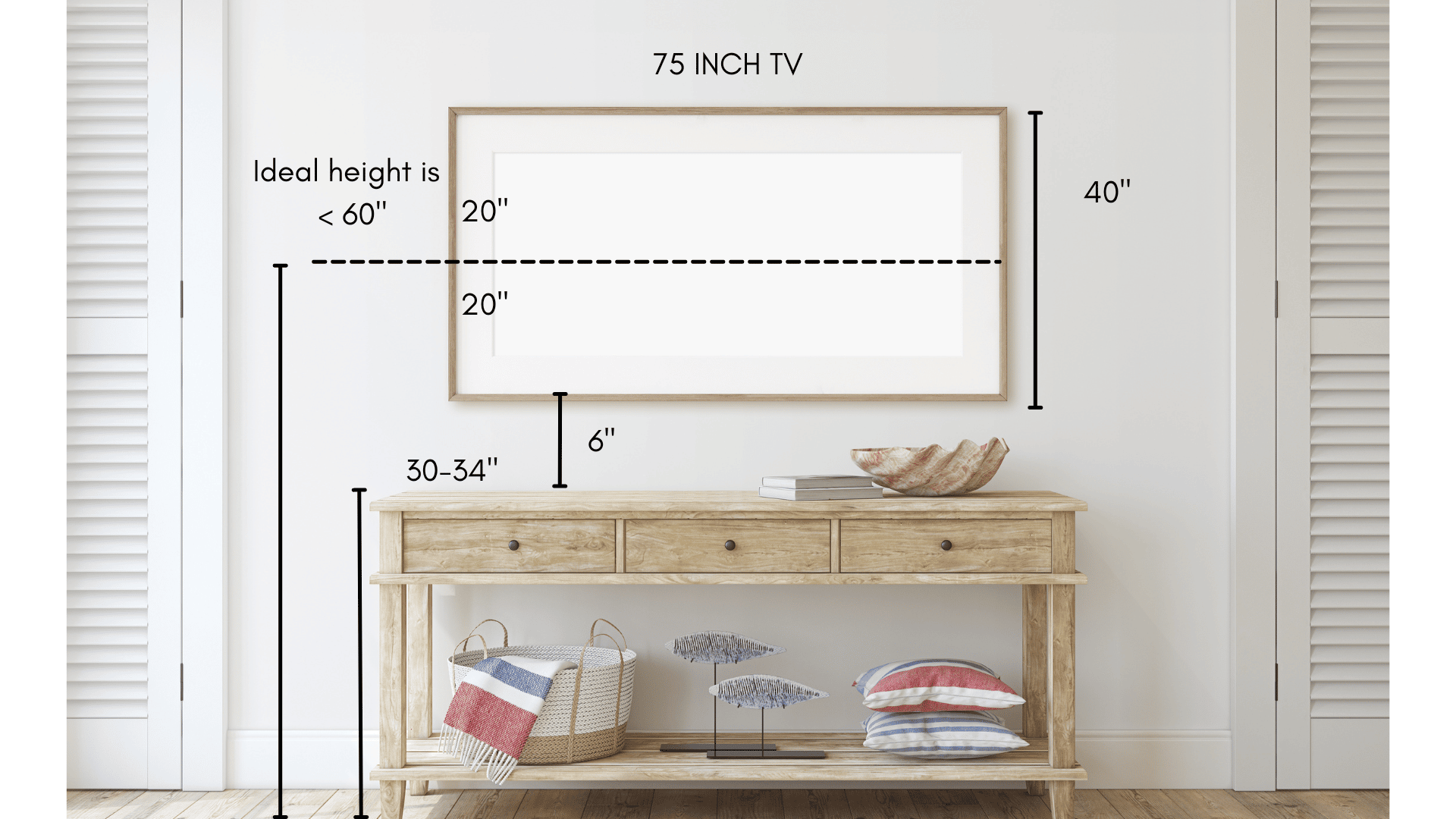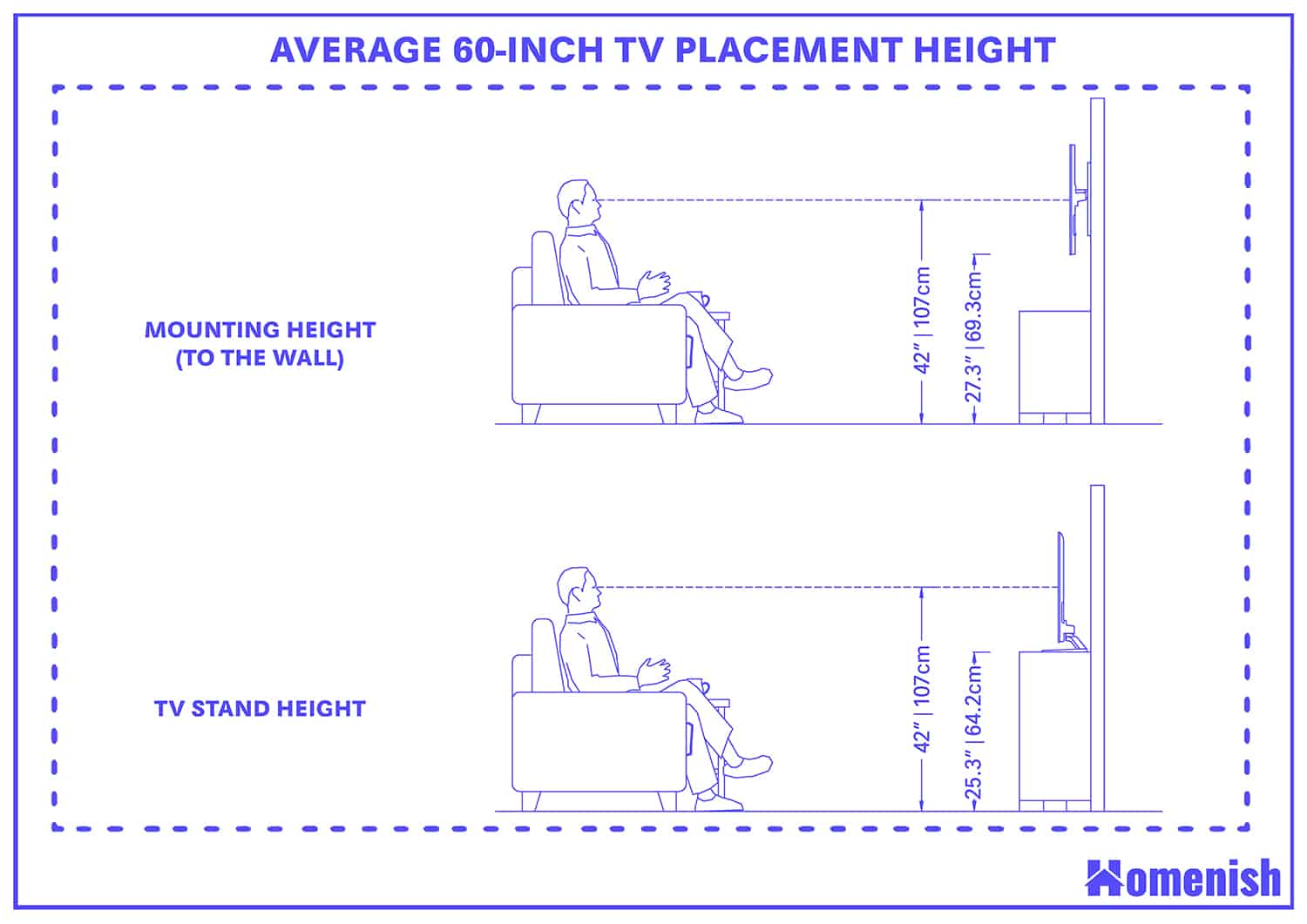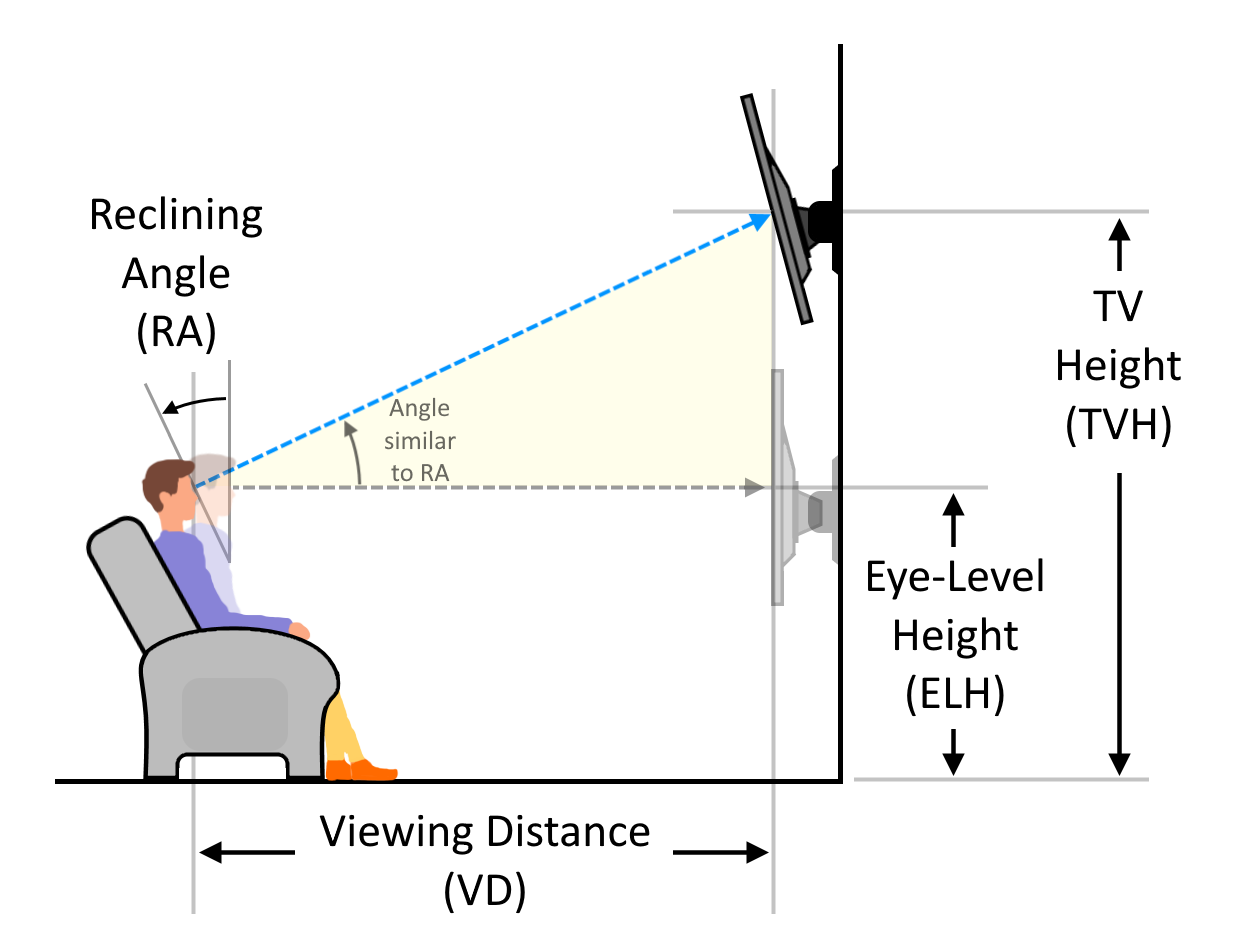Determining the Ideal Height

Getting your TV at the right height for your bedroom is crucial, mate. You want to be able to chill out and watch your favourite shows without straining your neck or eyes. There’s a few things you need to consider to get it just right.
Seating Distance and Optimal Viewing Angle
The distance between your seating and the TV plays a big part in finding the sweet spot for your TV. The optimal viewing angle is about 30-40 degrees, which means your eyes should be looking slightly downwards at the screen. Think of it like this: imagine a triangle with your eyes at the top, the TV at the bottom, and the base of the triangle being the distance between you and the TV. The angle of this triangle should be between 30-40 degrees.
- Example: If you’re sitting 10 feet away from the TV, the ideal height for the centre of the screen would be about 4-5 feet off the ground.
Ceiling Height
The height of your ceiling can also affect the placement of your TV. If you have a low ceiling, you might need to mount your TV lower to avoid it feeling cramped. On the other hand, if you have a high ceiling, you can mount it higher to create a more balanced look.
- Example: A 10-foot ceiling would allow for a higher TV mount than an 8-foot ceiling.
Personal Preference
Ultimately, the best height for your TV is the one that’s most comfortable for you. Some people prefer to have their TV mounted high, while others prefer it lower. There’s no right or wrong answer. It’s all about what feels good for you.
- Example: Some people prefer a higher mount for a more cinematic feel, while others prefer a lower mount for a more intimate viewing experience.
Ergonomics and Viewing Comfort, Bedroom tv wall mount height
Getting your TV height right isn’t just about looks, it’s about making sure you’re comfortable while watching. You want to avoid neck strain and eye fatigue.
- Tip: The centre of the screen should be at eye level when you’re sitting down. This will help you avoid tilting your head up or down to watch, which can lead to neck strain.
- Tip: Make sure your TV isn’t too bright or too dim. You should be able to see the screen clearly without having to squint.
Types of Wall Mounts and Their Features: Bedroom Tv Wall Mount Height

You’ve decided to mount your telly on the wall, but now you need to figure out which type of mount is right for you. There’s a whole spectrum of options, each with its own strengths and weaknesses. So, let’s break down the most common types of wall mounts and see which one fits your bedroom best.
Fixed Mounts
Fixed mounts are the simplest and most affordable type of wall mount. They’re designed to hold your TV securely in a fixed position, flush against the wall. This makes them ideal for bedrooms where you want a clean and minimalist look, and where the TV won’t need to be adjusted frequently.
Fixed mounts are a great choice if you’re looking for a simple and affordable way to mount your TV. They’re perfect for bedrooms where you want a clean and minimalist look and where you don’t need to adjust the TV frequently.
- Pros: Affordable, easy to install, secure, discreet.
- Cons: Limited adjustability, can be difficult to access ports and cables.
Bedroom tv wall mount height – Examples of common fixed mount designs include:
- Low-profile fixed mounts: These mounts sit very close to the wall, creating a sleek and unobtrusive look. They are a popular choice for bedrooms with limited wall space.
- Universal fixed mounts: These mounts are designed to fit a wide range of TV sizes and weights. They are a good option for those who want a versatile mount that can be used with different TVs.
Tilting Mounts
Tilting mounts offer a bit more flexibility than fixed mounts. They allow you to tilt the TV up or down, which can be helpful for bedrooms with low ceilings or angled viewing positions. This way, you can adjust the TV to get the best viewing angle, even if you’re sitting on the floor or on a bed.
Tilting mounts are perfect for bedrooms with low ceilings or angled viewing positions. They allow you to adjust the TV to get the best viewing angle, even if you’re sitting on the floor or on a bed.
- Pros: Affordable, easy to install, offer some adjustability, can improve viewing angles.
- Cons: Limited adjustability compared to full-motion mounts, can be difficult to access ports and cables.
Examples of popular tilting mount designs include:
- Tilting wall mounts with adjustable tilt angles: These mounts allow you to adjust the tilt angle of the TV to a wider range, providing greater flexibility in adjusting the viewing angle.
- Tilting wall mounts with a locking mechanism: These mounts have a locking mechanism that helps to prevent the TV from accidentally tilting. This can be helpful for bedrooms with children or pets.
Full-Motion Mounts
Full-motion mounts are the most versatile type of wall mount. They allow you to adjust the TV in multiple directions, including tilting, swiveling, and extending. This makes them perfect for bedrooms where you want to be able to watch TV from different angles, or where you need to move the TV out of the way when it’s not in use.
Full-motion mounts are the most versatile type of wall mount, allowing you to adjust the TV in multiple directions. They’re perfect for bedrooms where you want to be able to watch TV from different angles, or where you need to move the TV out of the way when it’s not in use.
- Pros: Offer the most adjustability, can be extended to reach different viewing positions, can be retracted to save space.
- Cons: More expensive than other types of mounts, can be more difficult to install, may require more wall space.
Examples of full-motion mount designs, highlighting their features include:
- Full-motion mounts with a swivel range of 180 degrees or more: These mounts allow you to rotate the TV to face any direction in the room, providing ultimate flexibility in viewing positions.
- Full-motion mounts with a long extension arm: These mounts allow you to extend the TV out from the wall, making it easier to view from different distances.
- Full-motion mounts with a cable management system: These mounts have a built-in cable management system that helps to keep the cables tidy and out of sight.
Installation Considerations and Safety Tips

Before you start drilling holes and hanging your telly, it’s crucial to consider a few things to ensure a safe and successful installation. This includes assessing the wall’s strength, managing those pesky cables, and taking the necessary safety precautions.
Wall Type and Strength
It’s a right pain in the neck to have your telly come crashing down, so it’s essential to make sure your wall can handle the weight. Different walls are built differently, and some are more sturdy than others. You wouldn’t want to be hanging a 65-inch monster on a plasterboard wall without some serious reinforcement.
Here’s how to suss out if your wall’s up to the job:
- Solid Walls: Brick, concrete, and block walls are the strongest. They can generally handle the weight of most TVs without any extra support. You can usually screw straight into these walls without too much hassle.
- Plasterboard Walls: These are more common, but they’re not as strong as solid walls. They need extra support, like using wall anchors or mounting the TV to a stud. You can usually tell if a wall is plasterboard by tapping on it; it’ll sound hollow.
- Drywall Walls: Similar to plasterboard, but with a thinner layer of plaster. They’re even less sturdy and require extra support, especially for larger TVs.
You can usually find out what type of wall you have by looking at the building plans or asking the landlord or previous owner. If you’re unsure, it’s always best to err on the side of caution and get professional advice.
Cable Management
Nobody likes a tangled mess of wires behind the telly. It’s a right eyesore and can be a real pain to deal with. So, you need to get those cables sorted out and keep things tidy.
Here are some ways to manage those pesky cables:
- Cable Ties: A classic for a reason! Use these to bundle the cables together neatly and keep them from getting tangled.
- Cable Concealers: These come in various forms, like raceways, channels, and sleeves, that can be used to hide cables along walls or behind furniture.
- Cable Management Boxes: These are a great way to keep cables organised and out of sight. They can be mounted behind the TV or on the wall.
- Wireless Connections: If possible, switch to wireless connections for devices like soundbars, streaming boxes, and even the TV itself. This can drastically reduce the number of cables you need to manage.
Safety Precautions
When you’re messing around with power tools and heavy objects, safety is paramount. You don’t want to end up with a broken telly or worse, a nasty injury.
Here are some safety tips to keep in mind:
- Always Disconnect Power: Before you start drilling or making any modifications, always unplug the TV and any other devices connected to it. This will prevent electrical shocks and accidents.
- Use Safety Glasses: When drilling or hammering, wear safety glasses to protect your eyes from flying debris.
- Use a Stud Finder: It’s vital to mount your TV to a stud for extra support, especially on plasterboard walls. A stud finder will help you locate the studs quickly and accurately.
- Don’t Overtighten Screws: Tighten screws firmly, but avoid overtightening, as this can damage the wall or the mount.
- Get Help If Needed: If you’re not comfortable with DIY or the installation seems too complex, don’t hesitate to call in a professional. It’s better to be safe than sorry.
Deciding on the perfect height for your bedroom TV wall mount is crucial for optimal viewing, and it can be a great opportunity to incorporate a stunning teal accent wall. If you’re looking for inspiration on how to create a beautiful and stylish teal accent wall, check out these teal accent wall bedroom ideas.
Remember, the TV should be at eye level when you’re sitting on your bed, so adjust the mount accordingly to ensure a comfortable viewing experience.
When deciding on the ideal height for your bedroom TV wall mount, consider the overall aesthetic of your space. A light pink bedroom wall, like the ones featured in this article , can create a calming and sophisticated atmosphere.
To ensure optimal viewing angles and comfort, aim for a TV height that aligns with your eye level when seated on your bed. This will help create a seamless blend between your décor and your entertainment setup.